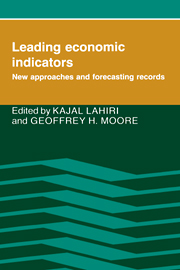Book contents
- Frontmatter
- Contents
- Preface
- List of contributors
- 1 Introduction
- PART I NEW CONCEPTS AND METHODS
- PART II FORECASTING RECORDS AND METHODS OF EVALUATION
- 9 Forecasting cyclical turning points: The record in the past three recessions
- 10 Turning point predictions, errors, and forecasting procedures
- 11 Forecasting peaks and troughs in the business cycle: On the choice and use of appropriate leading indicator series
- 12 Using a consensus of leading economic indicators to find the right ball park for real GNP forecasts
- 13 Some Australian experience with leading economic indicators
- 14 Turning point prediction with the composite leading index: An ex ante analysis
- 15 Forecasting recessions under the Gramm-Rudman-Hollings law
- 16 Leading indicators of inflation
- PART III NEW ECONOMIC INDICATORS
- Index
14 - Turning point prediction with the composite leading index: An ex ante analysis
Published online by Cambridge University Press: 05 June 2012
- Frontmatter
- Contents
- Preface
- List of contributors
- 1 Introduction
- PART I NEW CONCEPTS AND METHODS
- PART II FORECASTING RECORDS AND METHODS OF EVALUATION
- 9 Forecasting cyclical turning points: The record in the past three recessions
- 10 Turning point predictions, errors, and forecasting procedures
- 11 Forecasting peaks and troughs in the business cycle: On the choice and use of appropriate leading indicator series
- 12 Using a consensus of leading economic indicators to find the right ball park for real GNP forecasts
- 13 Some Australian experience with leading economic indicators
- 14 Turning point prediction with the composite leading index: An ex ante analysis
- 15 Forecasting recessions under the Gramm-Rudman-Hollings law
- 16 Leading indicators of inflation
- PART III NEW ECONOMIC INDICATORS
- Index
Summary
On the day of its release, the preliminary estimate of the Department of Commerce composite index of leading indicators (CIA) is widely reported in the popular and financial press. Although declines in the composite leading index are often regarded as a potential signal of the onset of a recession, evaluations of the ability of the CLI to predict turning points have been limited in most previous studies by the use of final, revised CLI data. However, the composite leading index is extensively revised after each preliminary estimate; not only are revisions made as more complete historical data become available for the components, but ex post, the statistical weights are updated and components are added or eliminated to improve leading performance. Forecasts constructed with an ex post, recomputed CLI may differ from real-time forecasts based on the contemporaneous, original construction CLI. In this chapter, we perform a completely ex ante, or real-time, evaluation of the ability of the CLI to predict turning points by using the original preliminary estimates and revisions as they became available in real time.
In section 14.1, we describe revisions in the CLI and our procedure for generating ex ante turning point probability forecasts from the CLI. The methodology is the Bayesian procedure described in Diebold and Rudebusch (1989), adapted to a newly constructed ex ante dataset. This new dataset, which has over 70,000 elements, contains every preliminary, provisionally revised, and final estimate of the CLI since the inception of the index in 1968.
- Type
- Chapter
- Information
- Leading Economic IndicatorsNew Approaches and Forecasting Records, pp. 231 - 256Publisher: Cambridge University PressPrint publication year: 1991
- 18
- Cited by



